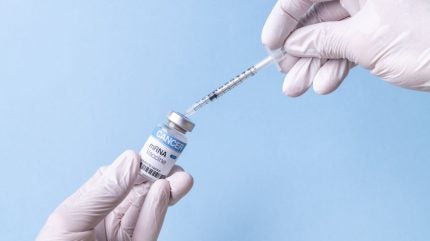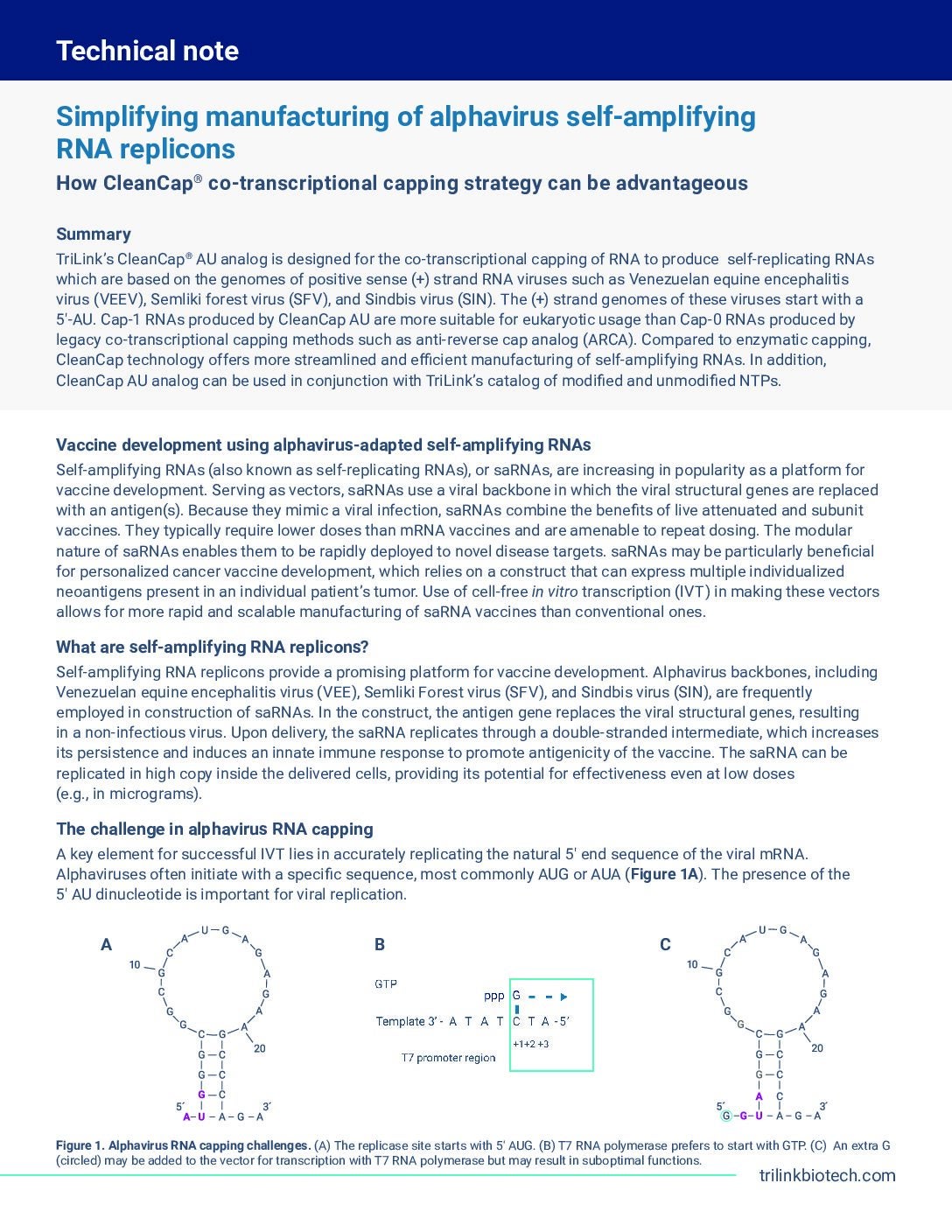

A year after bursting onto the scene amid the RNA renaissance, scientific challenges and regulatory resistance have held back self-amplifying messenger RNA (samRNA) vaccines from taking over the vaccine space. But experts say their time could soon be here.
Large vaccine companies are reluctant to invest too heavily in the emerging technology due to a gap in knowledge, especially compared to mRNA therapeutics. Despite this, those familiar with samRNAs are confident these therapies and vaccines will inevitably enter the market, particularly for infectious diseases and cancer.
However, it has not been smooth sailing for biotechs investing in this technology. Earlier this month, Emeryville, California-based samRNA leader Gritstone Bio filed for bankruptcy and is undergoing major financial restructuring. Moreover, technical complexity combined with growing confidence in established mRNA vaccines means the smaller companies leading the samRNA charge face an uphill climb in establishing the attractiveness of these approaches as they navigate approval.
Pune, India-based Gennova Biopharmaceuticals’ Gemcovac was the first samRNA vaccine to enter the market, gaining emergency approval in India against SARS-CoV-2 Omicron in 2022. In November 2023, Kostaive (ARCT-154), developed by Arcturus Therapeutics and CSL Behring, was the first samRNA vaccine to gain full marketing approval in Japan to treat Wuhan-Hu-1 strain SARS-Cov-2. Since its approval by the Japanese Pharmaceutical Affairs and Food Sanitation Council, no other samRNA vaccine or therapeutic approvals have followed.
Good fortune and strategic timing
According to Joseph Payne, CEO of Arcturus, Kostaive benefitted from special circumstances. “It’s simply because our vaccine was accelerated by the pandemic,” he said, “All of the large vaccine players have strong to very strong interest in samRNA vaccines. However, we were the only one that was able to complete a placebo-controlled efficacy trial during the pandemic.”
The Phase I/II/III trial ARCT-154-01 (NCT05012943) enrolled over 19,000 participants to study the safety and efficacy of Arcturus’s candidate. Among participants neither previously infected by SARS-Cov-2 nor previously vaccinated against it, Kostaive was found to offer 56.6% protection against infection, achieving the trial’s primary endpoint.

US Tariffs are shifting - will you react or anticipate?
Don’t let policy changes catch you off guard. Stay proactive with real-time data and expert analysis.
By GlobalDataPayne attributed the company’s success in part to, “good fortune and strategic timing”. Vietnam, having effectively quarantined itself against the initial waves of the pandemic, maintained a significant population naïve to Covid-19 antigens and was therefore uniquely eligible for a widescale trial.
Additionally, Payne noted that “Japan was the first country to allow us to do a direct comparison Phase III trial with the Pfizer vaccine.” This is in reference to a Phase III trial (jRCT2071220080) comparing Kostaive to Pfizer’s mRNA vaccine Comirnaty (tozinameran). In the study, Kostaive elicited higher geometric mean titers of Wuhan-Hu-1 neutralizing antibodies than Comirnaty (5,641 vs 3,934, respectively), as per (Oda et al.; Lancet Infect Dis 2024 Apr;24(4):351-360).
The effect of Covid-19
samRNA therapeutics build on standard mRNA vaccines, wherein an mRNA strand encodes a protein presented by a given virus, cancer cell, or other target; this protein is produced within host cells upon vaccination, inducing an immune response. samRNA therapeutics also include RNA encoding a replicon, which is a complex of proteins that produce further copies of the immunizing mRNA.
The Covid-19 pandemic accelerated mRNA technology, the basis of samRNA therapeutics, by globally focusing resources and regulators’ attentions. In comparison to mRNA vaccines, samRNA is theoretically positioned to resolve cost and reactogenicity drawbacks seen with the former.
When asked about the effect of Covid-19 on samRNA development, Dr. Gorben Pijlman, professor of Arbovirology & Medical Biotechnology at Wageningen University in the Netherlands, said the pandemic focused attention on mRNA as a technology in a positive way. In particular, the development of lipid nanoparticle (LNP) technologies would not have occurred if it were not for the pandemic, he adds.
However, Pijlman also points out that while Kostaive is the only human vaccine that is approved based on samRNA, those used for veterinary applications have been approved for much longer. For example, Ames, Iowa-based Harrisvaccines, now a part of MSD Animal Health, gained USDA approval in 2012 for a samRNA vaccine against swine influenza H3N2 based on its “SirraVax” replicon technology.
Absence of big players
Companies like Gritstone Bio, whose cancer vaccine GRANITE-001 is in a Phase II/III trial for colorectal cancer (NCT05141721), and VLP Therapeutics, which has a Covid-19 vaccine in a Phase III trial (jRCT2051230141), are close behind Arcturus therapeutics in the samRNA field. A host of other companies like Philadelphia, Pennsylvania-based Chimeron Bio, New Westminster, Canada-based Eyam Vaccines and Immunotherapeutics, and Zwijnaarde, Belgium-based Ziphius Vaccines have candidates in preclinical development. However, many of the usual global leaders in vaccinology, particularly for mRNA vaccines, are notably absent.
This is likely due to a crucial lack of experience, says Dr. Cristian Smerdou Picazo, director of Gene Therapy and Regulation of Gene Expression at the University of Navarre, Spain. Pfizer and BioNTech, he notes, were initially developing a samRNA Covid-19 vaccine together, “but they decided to go quicker with the mRNAs because there was already some experience with the mRNAs in humans, so they thought it was going to be easier to get approval, while for the samRNA there was no experience.”
According to Smerdou, even several years of experience with mRNA vaccines “maybe are not translatable to the samRNA.” Additionally, some potentially unresolved concerns surrounding samRNA technology still remain, he says. In particular, he highlights that with samRNA, “you are not only expressing the antigen.” The replicon-encoded protein, he says, may elicit its own immune response independent of the antigen payload, possibly limiting the long-term efficacy of booster samRNA doses.
“There are two technical hurdles” to achieving efficacy with a samRNA therapeutic, says Andreas Suhrbier, PhD, head of the Inflammation Biology Group at QIMR Berghofer, Brisbane, Australia. One is that mRNA nucleosides must be modified to prevent the induction of type I interferons that hamper replication; many modified nucleosides like N1-methylpseudiuridine work well for standard mRNA vaccines but not samRNAs.
The other hurdle, according to Suhrbier, is a question of RNA size. Roughly 4,000 nucleosides encode the replicon component of samRNAs. Even a small degradation or alteration can reduce the efficiency of the entire construct and, by extension, the vaccine, he explains.
Suhrbier believes that though solutions to these challenges are being found, poor understanding of RNA in general is limiting therapeutic development. “There’s just a very large arrangement of unknowns where money can be invested”, he says, resulting in indecision from the traditional leaders of the industry.
Future development
As a complex, cutting-edge technology, samRNA has been the subject of a similar host of safety concerns. In the ARCT-154-01 study, for example, 89.6% of vaccinated participants reported at least one adverse event after one Kostaive dose. But, as with many mRNA Covid-19 vaccines, this seemingly high reactogenicity was mostly composed of mild reactions that resolved within two to four days.
Even so, Smerdou asks if the demonstrated efficacy of candidates like Kostaive justifies these side effects. “[56.6% protection] is low,” he says. However, Arcturus’s Payne notes that Kostaive demonstrated 95.3% protection against severe Covid-19 in the same trial, a metric which he says is a greater priority to regulatory authorities.
Though experts emphasize its potential, the future is not certain for samRNAs. According to Pijlman, samRNA vaccines against cancers and infectious diseases are expected to appear in coming years, but this approach may not be the first choice in many cases. If it is to thrive, samRNA technology might have to overcome more than technical difficulties.
mRNA vaccine coverage on Pharmaceutical Technology (or Clinical Trials Arena) is supported by Trilink. Editorial content is independently produced and follows the highest standards of journalistic integrity. Topic sponsors are not involved in the creation of editorial content.




